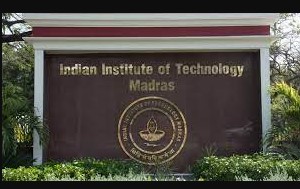
The Indian Institute of Technology Madras is known both nationally and internationally for excellence in technical education, basic and applied research, innovation, entrepreneurship and industrial consultancy. A faculty of international repute, a highly motivated and brilliant student community, excellent technical and supporting staff and an effective administration have all contributed to the pre-eminent status of IIT Madras. The Institute is proud to bear the laureate of being No.1 engineering university in India. More recently, IIT Madras has been given the title of Institute of Eminence.
In 1956, the German Government offered technical assistance for establishing an institute of higher education in engineering in India. The first Indo-German agreement in Bonn, West Germany for the establishment of the Indian Institute of Technology at Madras was signed in 1959.
The Institute was formally inaugurated in 1959 by Prof. Humayun Kabir, Union Minister for Scientific Research and Cultural Affairs. The IIT system has sixteen Institutes of Technology – the first of these to be instituted were at Kharagpur (estb. 1951), Mumbai (estb. 1958), Chennai (estb. 1959), Kanpur (estb. 1959), Delhi (estb. 1961), Guwahati (estb. 1994) and Roorkee (estb. 1847, joined IITs in 2001).
A globally recognised Institute:-
IIT Madras is a residential institute with nearly 550 faculty, 8000 students and 1250 administrative & supporting staff and is a self-contained campus located in a beautiful wooded land of about 250 hectares. The campus is located in the city of Chennai, previously known as Madras. Chennai is the state capital of Tamilnadu, a southern state in India.
The Institute has sixteen academic departments and a few advanced research centres in various disciplines of engineering and pure sciences, with nearly 100 laboratories organised in a unique pattern.
IIT Madras has been the top-ranked engineering institute in India for four consecutive years as well as the ‘Best Educational Institution’ in Overall Category in the NIRF Rankings of 2019 put out by the Ministry of Human Resource Development.
Insti Lingo:-
Any visitor to IIT Madras who spends a few minutes in the campus will find themselves in the midst of conversations that are happening in a different tongue. This is our very own Insti lingo – the IIT Madras lingo – which include words that extend beyond the realm of the bulkiest Oxford Dictionaries or the most exhaustive Websters.
Over the years, our students have developed their own indigenous vocabulary that symbolises the two traits of an IITian that distinguish him from the average guy next door—creativity and brevity. Simple phrases , such as “I crashed da...”, “Psued da.. ” or “Don’t put psued macha!”, will eventually come to make sense to a resident, who will marvel at the ingenuity of the lingo as they come to terms with it.
A technological enterprise at the service of the Nation:-
The Indian Institute of Technology Madras belongs to the new-generation institutes of national importance in higher technical education. Located in South Chennai, in a beautiful campus spanning 630 acres, the Institute is nearly self-contained and houses around 3000 students as well as the families of faculty and staff members. The Institute has grown from strength to strength ever since it obtained its charter from the Parliament of India in 1961, and has since established itself as a premier centre of research, consultancy and technological development.
The dawn of a new era:-
It all began in 1956, when Pandit Jawaharlal Nehru, Prime Minister of India, was on an official visit to West Germany and was offered assistance by the Government of the Federal Republic of Germany, to set up a higher technological institute in India. This resulted in the signing of the first Indo-German Agreement in Bonn in 1959, for the establishment of an Indian Institute of Technology at Madras. The first Indo-German Agreement provided for the services of German professors and five foremen, training facilities for 20 Indian faculty members and the supply of scientific and technical equipment for the establishment of the Central Workshop and 20 laboratories at IIT Madras.
In 1959, the Institute was formally inaugurated by Prof. Humayun Kabir, Union Minister for Scientific and Cultural Affairs. Dr. A. Lakshmanaswamy assumed office as the first Chairman of the Board of Governors and Dr. B.Sengupto as the first Director of the Institute. In 1961, the Institute was declared as an 'Institute of National Importance' by the Parliament of India.
Milestones that defined an illustrious history:-
The visit of Dr. Heinrich Lubke, President of the Federal Republic of Germany, in 1962 marked the beginning of the Indo-German Technical Assistance Program. In 1973, Shri C.Subramaniam, Minister for Industrial Development and Minister for Science and Technology, inaugurated the Industrial Consultancy Centre. The same year, the first IBM System 370 Model 155 digital computer was dedicated to the Institute.
1974 witnessed the commencement of the fourth Indo-German Agreement. It aimed to set up inter-university partnerships in R&D projects, strengthen the industrial consultancy service and establish a post-graduate programme in Television Engineering. The Employees Welfare Scheme was introduced in 1975, and evening D.I.I.T courses were started for the benefit of engineers in and around the city.
In 1976, an agreement was signed with the Government of France for collaboration and assistance to the Aeronautics Department. Five years later, the fifth Indo-German agreement was signed with the continuation of inter-university projects and exchange visits, as well as the strengthening of the Micro Processor Laboratory, Low Temperature Laboratory and High Polymer Laboratory as its principal objectives. The credit system of evaluation for B.Tech. programmes was introduced in 1979.
Recognising world-class talent:-
Since 1973, the Institute has conferred honorary degrees of Doctor of Science and Doctor of Technology (honoris causa) to eminent personalities like Nobel Laureate (Physics) Dr. John Bardeen (1973), former Minister for Foreign Affairs (FRG) Mr.Hans Dietrich Genscher (1973) and former Chairman, Atomic Energy Commission, Dr.Raja Ramanna (1983) among others. Prominent in the academic calendar of the Institute is the Institute Convocation Day, the convocation address being delivered usually by the President, Vice-President or Prime Minister of India. President Shri Sarvepalli Radhakrishnan addressed the first convocation of the Institute. The 35th convocation address (in 1998) was delivered by the Honourable Vice-President of India, Shri Krishna Kant.
A General Charter:-
The Goals and Objectives were derived from the Sarkar Committee Report and embodied in the IIT Act. In addition to the Sarkar Committee report, the IIT Act and the Statutes of the IITs indicate the lines along which IITs should develop. According to these documents IITs are expected
to be higher technical institutions and research in some branches of Engineering on the lines of the Massachusetts Institute of Technology - better known as MIT;
to provide for instruction and research in some branches of Engineering and Technology, Science and Arts for the advancement of learning and dissemination of knowledge in specific branches.
The two broad objectives which emerge from the above line of development are
the advancement of knowledge through education and research, in both Pure and Applied Science, in Engineering, Social Science and Humanities;
service to the community and nation (which are referred to as Extension activity) through the use of their resources both intellectual and material, particularly through Continuing Education for professionals working in Industry.
The Science Policy Resolution (SPR) of the Government of India (1958) is a basic document of relevance to the IITs. The SPR resolves
to foster, promote and sustain scientific research in all aspects - pure, applied and educational;
to ensure adequate supply of research scientists of higher quality;
to recognize the work of research scientists as an important component of the strength of the nation;
to encourage programmes for the training of scientific and technical personnel to fulfill the country's needs in science and education, agriculture and industry, and defense;
to encourage dissemination and discovery of knowledge in an atmosphere of scientific freedom.
Credits
IITs also constitute a major source for research scientists of high caliber; they also are expected to serve the people of India and provide the country with benefits of application of their discovery and knowledge and as such are entitled to academic freedom and research support as implied in the SPR.
Much in the some manner as IITs are part of the successful implementation of the SPR, they now have a greater responsibility for fulfilling the relevant goals of the Technology Policy Statement as well. As Institutes of Technology, their charter, is to resonate the expectations spelt out in the Technology Policy Statement.
- The Technology Policy Statement (1983) affirms interalia, that
- technology must relate to our people's aspirations and to our local needs;
- technology covers both manufacturing and servicing sectors.
The Statement affirms that the base for this consists of trained manpower, which IITs are charged to develop. It envisages special attention to the promotion of newly emerging and frontier areas and encouraging research in these areas.
IITs have a specific role to implement these avowed objectives of the Technology Policy Statement within their general charter of education, research and extension.
Such goals require that IITs must:-
excel in all aspects of academic activity and produce a high quality science based engineering students;
survive on specialization, work increasingly in front-line areas that transcend disciplines;
have a perception and a value system appropriate to the pursuit of high science and high engineering science to meet the critically evaluated needs of the society in terms of products and processes using indigenous resources in close collaboration wit manufacturing service sectors;
programme into their activities the emerging technological needs with a futuristic outlook;
accept extension and public services as a third dimension to their role in addition to education and research;
attain a stature that enables them to provide leadership with credibility. They should be the "think tanks" for higher education and research;
aim at preparing more of "creative engineers", "innovative thinkers" and "engineer entrepreneurs";
develop a special nexus with rural development mainly by way of involvement in technology based solutions for problems in rural areas;
maintain and foster interactive linkages with leading technological institutions and centers of research in India and abroad.










